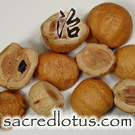Chuan Lian Zi (Sichuan Pagoda Tree Fruit)
Herb 3 of 19 in Herbs that Regulate the Qi
Buy This Herb
Get free shipping from
our partners at CHD
our partners at CHD
Chinese Herb Actions
- Moves and regulates Qi, Stops Pain For Liver Qi Stagnation with symptoms such as abdominal pain, pain and distention in the lower ribs and upper abdomen. As Chuan Lian Zi is Cold, it is useful when there are also heat signs such as red eyes and face, irritability, temper, insomnia. Also used for hernial pain (see notes).
- Kills Parasites and Fungus, and Stops Pain
For intestinal parasites such as roundworms, hookworms, and tapeworms accompanied by pain.
This herb can also be used topically for scalp fungus.
Chinese Herb Contraindications & Cautions
- Use cautiously in patients with cold deficiency of the Middle Jiao.
Herb-Drug Interactions
- Section not completed...
Chinese Herb Toxicity & Overdose
- Unprocessed Chuan Lian Zi is Slightly Toxic.
- This herb is considered toxic.
(while some Chinese herbs are toxic, it must be noted that many come prepared, or are combined, to mitigate their toxicity)
Chinese Herb Dosage
- 3-10 grams
Chinese Herb Notes
- Dry frying Chuan Lian Zi decreases it's toxicity, makes it easier to digest, and warms it's cold nature.
- Dry frying with salt increases this herb's affinity for the Kidneys, and is often used for disorders such as hernial pain.
This Herb Appears in the Following Formulas:
- Hei Xi Dan (Lead Special Pill)
Category: Formulas that Rescue Devastated Yang - Jin Ling Zi San (Melia Toosendan Powder)
Category: Formulas that Promote the Movement of Qi - Ju He Wan (Tangerine Seed Pill)
Category: Formulas that Promote the Movement of Qi - Tian Tai Wu Yao San (Top Quality Lindera Powder)
Category: Formulas that Promote the Movement of Qi - Yi Guan Jian (Linking Decoction)
Category: Formulas that Nourish and Tonify the Yin - Zhen Gan Xi Feng Tang (Sedate the Liver and Extinguish Wind Decoction)
Category: Formulas that Extinguish Internal Wind






